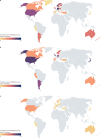Global epidemiology of vasculitis
- PMID: 34853411
- PMCID: PMC8633913
- DOI: 10.1038/s41584-021-00718-8
Global epidemiology of vasculitis
Abstract
The many forms of vasculitis are characterized by inflammation of blood vessels, leading to potentially long-term sequelae including vision loss, aneurysm formation and kidney failure. Accurate estimation of the incidence and prevalence has been hampered by the absence of reliable diagnostic criteria and the rarity of these conditions; however, much progress has been made over the past two decades, although data are still lacking from many parts of the world including the Indian subcontinent, China, Africa and South America. Giant cell arteritis occurs in those aged 50 years and over and seems to mainly affect persons of northern European ancestry, whereas Takayasu arteritis occurs mainly in those aged under 40 years. By contrast, Kawasaki disease mainly occurs in children aged under 5 years and is most common in children of Asian ancestry, and IgA vasculitis occurs in children and adolescents. Although much less common than giant cell arteritis, the different forms of antineutrophil cytoplasmic antibody-associated vasculitis are being increasingly recognized in most populations and occur more frequently with increasing age. Behçet syndrome occurs most commonly along the ancient silk road between Europe and China. Much work needs to be done to better understand the influence of ethnicity, geographical location, environment and social factors on the development of vasculitis.
© 2021. Springer Nature Limited.
Conflict of interest statement
R.A.W. declares sponsorship of less than $10,000 from Gilead. G.H. declares payments of less than $10,000 from Abbvie, Amgen, Bayer, Celgene, Johnson & Johnson, Lilly, Novartis and UCB Pharma. A.J.M. declares payments of less than $10,000 from Amgen Sweden, Lilly Sweden and Roche Sweden. J.C.B. declares no competing interests.
Figures




Similar articles
-
Epidemiology of the vasculitides.Semin Respir Crit Care Med. 2004 Oct;25(5):455-64. doi: 10.1055/s-2004-836139. Semin Respir Crit Care Med. 2004. PMID: 16088491
-
Vasculitis in Africa.Curr Rheumatol Rep. 2018 Feb 21;20(2):4. doi: 10.1007/s11926-018-0711-y. Curr Rheumatol Rep. 2018. PMID: 29464351 Free PMC article. Review.
-
Epidemiology of systemic vasculitis.Curr Rheumatol Rep. 2005 Aug;7(4):270-5. doi: 10.1007/s11926-005-0036-5. Curr Rheumatol Rep. 2005. PMID: 16045829 Review.
-
Introduction, epidemiology and classification of vasculitis.Best Pract Res Clin Rheumatol. 2018 Feb;32(1):3-20. doi: 10.1016/j.berh.2018.10.003. Epub 2018 Nov 16. Best Pract Res Clin Rheumatol. 2018. PMID: 30526896 Review.
-
Epidemiology of systemic vasculitis.Curr Opin Rheumatol. 2024 Jan 1;36(1):21-26. doi: 10.1097/BOR.0000000000000983. Epub 2023 Oct 5. Curr Opin Rheumatol. 2024. PMID: 37800639 Review.
Cited by
-
Case Report: Interventional therapy for portal venous stenosis caused by systemic vasculitis.Front Immunol. 2022 Oct 12;13:1005300. doi: 10.3389/fimmu.2022.1005300. eCollection 2022. Front Immunol. 2022. PMID: 36311772 Free PMC article.
-
Incidence and clinical manifestations of giant cell arteritis in Spain: results of the ARTESER register.RMD Open. 2024 Mar 26;10(1):e003824. doi: 10.1136/rmdopen-2023-003824. RMD Open. 2024. PMID: 38531620 Free PMC article.
-
The Future of Giant Cell Arteritis Diagnosis and Management: A Systematic Review of Artificial Intelligence and Predictive Analytics.Cureus. 2024 Dec 5;16(12):e75181. doi: 10.7759/cureus.75181. eCollection 2024 Dec. Cureus. 2024. PMID: 39764337 Free PMC article. Review.
-
Autoantibody hotspots reveal origin and impact of immunogenic XIST ribonucleoprotein complex.bioRxiv [Preprint]. 2025 Jan 20:2025.01.16.633465. doi: 10.1101/2025.01.16.633465. bioRxiv. 2025. PMID: 39896599 Free PMC article. Preprint.
-
Age-Related Variations in the Clinical Presentation and Treatment Outcomes of New-Onset GPA: A Longitudinal Study.J Clin Med. 2025 Feb 25;14(5):1544. doi: 10.3390/jcm14051544. J Clin Med. 2025. PMID: 40095487 Free PMC article.
References
-
- Newburger JW, Takahashi M, Burns JC. Kawasaki disease. J. Am. Coll. Cardiol. 2016;67:1738–1749. - PubMed
-
- Jennette J, et al. 2012 revised international Chapel Hill Consensus Conference nomenclature of vasculitides. Arthritis Rheum. 2013;65:1–11. - PubMed
-
- Fries JF, et al. The American College of Rheumatology 1990 criteria for the classification of vasculitis. Summary. Arthritis Rheum. 1990;33:1135–1136. - PubMed

